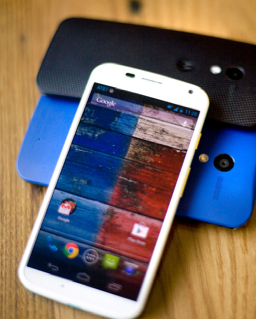 Google’s new phone, the Moto X, enables its owners to take command of their digitized world without pressing a button, making a gesture or touching a screen. Even when it is turned-off, the device is always listening for the words “Okay Google Now” in order to activate.
Google’s new phone, the Moto X, enables its owners to take command of their digitized world without pressing a button, making a gesture or touching a screen. Even when it is turned-off, the device is always listening for the words “Okay Google Now” in order to activate.
As Greg Sterling notes in his post on Internet2Go, Touchless Control is one of the distinctive features of the new device. It marks a major step by Google to promote acceptance and mass adoption of its brand of smartphone as the preferred PVA (personal virtual assistant) for millions of individuals. Given that Google paid over $12 billion for Motorola Mobility, the mobile phone manufacturing subsidiary of Motorola, building a compelling bond between people and machines will be crucial to recouping its investment.
So far, the phones have only been demonstrated to a small group of journalists in New York City. “Touchless Control” is the marketing term that Google has assigned to its truly hands-free voice command features. Among other things, the device is always listening for the words “Okay Google Now.” Once activated in this manner the phone will respond to spoken commands and perform all the wonderful activities that “predictive” or “anticipatory” search make possible.
Based on press coverage, it is hard to tell whether the voice activation resource includes speaker identification and verification. At Voice Biometrics Conference-San Francisco in March, Sensory, Inc.’s CEO Todd Mozer demonstrated the capability of his company’s embedded software to recognize wake-up words as well as the speaker of those words, both at a distance and in relatively noisy environments. In this blog post, Sensory confirms that it has licensed its technology to Google/Moto, Samsung and others. The post also has a link to a year old video demo of the “trigger-to-search” function.
Google is well aware that user authentication is a vital function of smartphones both for privacy protection and personalization. Making authentication part of the activation function would be a nice touch, but Google has also shown several other approaches to user authentication that would streamline the process of asserting identity when activating a device. One involves simply carrying a small device like a key fob. If the sensors on the phone detect its proximity, it can feel confident enough to carry out designated tasks on the owner’s behalf.
Of course Google has other ideas for authentication. At the All Things D D11 conference last may, a Google executive demonstrated other ideas that included a tattoo, as well as ingesting a small capsule (like a vitamin), whereby “the swallower’s whole body becomes a password.” She also said that such things “aren’t likely to ship soon, but the Moto X phones will be available in the retail stores in the U.S. Canada and Latin America starting late August or early September. AT&T, Verizon, Sprint, T-Mobil and U.S. Cellular are the initial carriers in the U.S.
Categories: Intelligent Assistants, Articles

 NiCE Interactions 2025: Agentic AI, Better Data, and a Whole Lot of Partnership
NiCE Interactions 2025: Agentic AI, Better Data, and a Whole Lot of Partnership  Getting It Right: What AI Agents Actually Mean for Customer Support (Webinar)
Getting It Right: What AI Agents Actually Mean for Customer Support (Webinar)  Beyond the Basics: How AI Is Transforming B2B Sales at TP
Beyond the Basics: How AI Is Transforming B2B Sales at TP  Five9 Launches Agentic CX: Toward AI Agents That Reason and Act
Five9 Launches Agentic CX: Toward AI Agents That Reason and Act